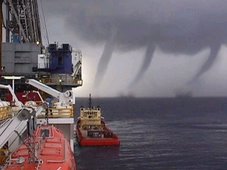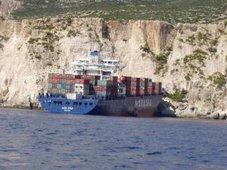 For Hurricanes, Storms, Raindrop Size Makes All The Difference
For Hurricanes, Storms, Raindrop Size Makes All The DifferenceScienceDaily (Jun. 13, 2008) — When Tropical Storm Gaston hit Richmond, Va., in August 2004, its notable abundance of small and mid-sized raindrops created torrential rains that led to unexpected flash flooding throughout the city and its suburbs. New research from NASA has concluded that tropical cyclones like Gaston produce rain differently than another class of storms called "extra-tropical" cyclones. According to the study, making a proper distinction between these systems by looking at both raindrop size and abundance may be a key to assisting weather forecasters in estimating rainfall intensity. By doing so, forecasters can reduce the surprise factor of flash flooding and the unfortunate loss of property and life.
Ali Tokay, a research scientist from the Joint Center for Earth Systems Technology (JCET) at the University of Maryland Baltimore County, Baltimore, and NASA's Goddard Space Flight Center, Greenbelt, Md., compared the rain measurements collected in tropical storms and hurricanes during the past three Atlantic hurricane seasons with measurements after these storms transitioned to being extra-tropical. Tokay's study appeared in the May issue of the American Meteorological Society's Monthly Weather Review.
When a tropical cyclone -- the generic name for tropical depressions, tropical storms and hurricanes -- merges with a mid-latitude frontal storm system, measurable changes to the raindrop size and abundance occur as the system transitions to become extra-tropical. Extra-tropical cyclones also form outside the tropics without being part of a tropical system, and tend to form over land rather than over the open ocean. This category of storm can produce anything from a cloudy sky to a thunderstorm as it develops between weather fronts, the boundaries separating air masses of different densities.
Tokay looked at raindrop size, rain intensity, and the area in which rain falls in both tropical cyclones and extra-tropical cyclones using ground-based rain-measuring instruments called disdrometers. These instruments measure the range of raindrop sizes in a storm and the intensity of the rainfall. The disdrometer is an important part of the ground-based rain measuring instruments that are used to validate rainfall seen from satellites including the Tropical Rainfall Measuring Mission (TRMM), a joint mission with NASA and the Japanese Space Agency. He concluded that tropical cyclones that form over water tend to rain harder and have a greater amount of smaller drops before they transition to being extra-tropical with raindrops of larger size and mass.
"Torrents of rainfall from tropical storms are not surprising since the systems are large and move slowly. It is also true that slow moving frontal systems associated with an extra-tropical cyclone can result in abundant rainfall at a site," said Tokay. "What is less known is that the distribution of raindrops within a volume of air between the two systems differs substantially even though weather radar may measure the same returned power which is known as reflectivity." This is why disdrometer measurements of raindrop size are needed.
"Both rain intensity and reflectivity are integral products of raindrop size distribution, but they are mathematically related to different powers of the drop size," said Tokay. Weather radars cannot measure the range of raindrop sizes. As a result, rainfall estimates from weather radars must employ the use of equations that make assumptions about raindrop size. These assumptions can result in underestimation of rain intensity, and the possibility of deadly flooding.
In the study, Tokay uses disdrometer data from various sites around the U.S. and abroad. Most of the data were collected at NASA's Wallops Flight Facility, Wallops Island, Va., where Paul Bashor of Computer Sciences Corporation, Wallops Island, Va. maintains several types of disdrometers. The data from two tropical storms were collected at Orlando, Fla., and Lafayette, La. through collaborative efforts with Takis Kasparis at the University of Central Florida's Orlando campus, and Emad Habib of the University of Louisiana at Lafayette.
WEATHER NOTE
Hurricane simulator could make homes safer
MARK COLVIN: The hurricane season is underway on America's Atlantic Coast and forecasters are predicting a busy few months. They're expecting somewhere between 12 and 16 storms that are serious enough to get a name.Up to five of those could turn into major hurricanes, but the experts are onto it.
The University of Florida has created the world's biggest hurricane simulator aimed at protecting millions of homes from potential devastation.
What's called a hurricane in the northern hemisphere is a cyclone in Australia, so the findings could be also be useful here, as Jayne Margetts reports.
(Sound of the hurricane simulator idling)
JAYNE MARGETTS: It may sound like a high powered sports car. But it's the world's first hurricane simulator.
The machine is designed to test what hurricanes can do to people's homes so that they can be better protected. It's capable of producing winds in excess of 200 kilometres per hour and making up to 90 centimetres of rain.
Florida University's Forrest Masters is in charge of the project:
FORREST MASTERS: We've harnessed 2,800 horsepower, a locomotive's worth of power to recreate a wind field large enough to envelop part of a single family home.
In the late 1990s we began deploying into hurricanes to take measurements, and the simulator you see here is our first effort to bring the hurricane back into the laboratory to evaluate building systems, urban landscaping and really anything that could find its way into the path of a hurricane.
JAYNE MARGETTS: It wouldn't look out of place on the set of a science fiction movie. Eight industrial fans, each well over a metre high have been strapped together. At the back of the machine huge silver pipes suck in air from different directions.
The simulator is run by four marine diesel engines. A 20,000-litre water tank is needed just to keep them cool.
Laboratory manager Jimmy Jesteadt says it'll help find ways of protecting the homes and lives of millions of people.
JIMMY JESTEADT: We've had many years of going into the field after a hurricane has passed through and you definitely get your reality check when you see the thousands of people that have been misplaced from their homes and basically what we're in this for is – the civil engineering aspect of it – is to make the homes last for people's safety.
JAYNE MARGETTS: The scientists have built a makeshift house, and placed it in the path of the simulator. Eventually they hope to design water resistant windows, windproof roof tiles and stronger structures.
Mr Masters says it's a personal mission for many of the team members.
FORREST MASTERS: The students that staff the project grew up in hurricane-prone areas. It’s part of their culture and now they're getting the chance to come back into a laboratory setting and do something about it.
JAYNE MARGETTS: Dr Michael Coughlan is from the Australian Bureau of Meteorology.
MICHAEL COUGHLAN: Well, it's certainly a very impressive piece of equipment. It doesn't actually simulate hurricanes per se, but what it does do is simulates the wind speed and rain conditions, rainfall conditions that one might experience in a hurricane.
And of course, it does this on, you know, fairly large scale, much bigger of course than one would normally do inside a wind tunnel in a laboratory where one could put a model inside the wind tunnel and then subject the model to strong winds.
In this case, the machine is big enough that they can actually use it out in the open and use it on real houses.
MARK COLVIN: Dr Michael Coughlan ending that report by Jayne Margetts
Strong typhoon may hit Southern Vietnam
VietNamNet Bridge - Unpredictable floods, tropical depressions and rainstorms will be stronger this year than in previous years. Violent storm like Cyclone Nargis, a strong tropical cyclone that caused the deadliest natural disaster in the recorded history of Burma (Myanmar), may hit Viet Nam during the current rainy season.
Typhoons on East Sea could be stronger than in previous years, said Tran The Kiem of the Central Hydro-Meteorological Forecast Center.
Meteorologists warned that a strong hurricane could strike the Mekong delta.
If a cyclone of force 13 or higher pounds the delta, it will cause tremendous losses because the region is rarely hit by major storms.
Hence there is no public awareness or experience in dealing with them, according to the National Committee on Search and Rescue. In addition, many buildings in the area are not well built.
A tropical low pressure area continued to bring showers to parts of North and North Central regions on Sunday, according to the National Hydro-meteorology Forecast Center.
Because torrential rains poured down for several days in the North, more water has flowed into the reservoir of the Hoa Binh Hydroelectric Power Plant. Water was flowing in at a rate of nearly 4,000 cubic meters per second. The water level on the Hoa Binh River on Sunday rose 3m to 91.5m.
The tropical low pressure could bring heavy but isolated showers and thunderstorms to the North and North Central regions before weakening. In the Highlands and in the South, there will be gusts and rains with temperatures of 20°C to 34°C
Gustnado-D
MARITIME NOTE
Captain describes tragedy at sea
Everything happened so quickly.
Recovering at home in Seacow Pond, P.E.I. on Wednesday, Casey Gavin recalled how a routine fishing trip suddenly turned tragic early Sunday morning.
Gavin, the owner of the ill-fated Toys for Big Boys, and two of his crewmembers had turned in for the night while Danny Ellsworth took charge of sailing the boat home to Tignish.
“I heard Danny saying, ‘You’d better get up. Something’s wrong.’”
“I looked to the stern of the boat. It was already under water.”
Gavin yelled to crewmembers Kyle Costain and Brian DesRoches to get up. “She’s going down,” he warned.
“I took the life raft off the cab of the boat. I threw it down and she blew up. The four of us got into her.”
The stern of the fibreglass boat was now submerged and the water pressure caused the wooden deck to break free.
The bow was out of the water 20 feet and then went straight down.
“From the time I got up and the four of us were in the life raft was less than a minute and the boat was gone,” Gavin related. “That’s how fast she went.”
The crew of four was in a life raft, but they weren’t safe. The weight of the ropes now sinking to the bottom caused the deck to flip over in slow motion, Gavin said.
“We were pushing with all we were worth,” but they couldn’t get out of its way.
The deck flipped over on top of their small craft, trapping the crew beneath it. Three of them were able to fight their way clear, but Ellsworth did not resurface.
There were ropes floating all around them, and they had to fight through. Gavin, a non-swimmer, was the first to make it back to the deck and helped Costain onto it.
They cut buoys free and threw them to DesRoches until he was able to grab onto one and get to the deck.
They called and called to Ellsworth but got no response.
For two hours, Gavin estimates, the three men braced themselves on the deck, the waves sometimes breaking over them. Pieces of deck kept breaking off and, as they did, their section of deck sank deeper, until they were neck-deep in water.
They had gathered up buoys and tied them together, figuring they’d tie themselves to them if their platform sank from beneath them.
The men had become aware their raft was beneath the platform and, when another piece broke away the raft resurfaced, upside down. It took all their strength to right it and climb inside.
Only after hearing a fishing boat in the distance did they set off emergency flares, preferring not to waste them in the fog.
The cause of the boat sinking has not been determined, but Gavin said Coast Guard personnel indicated a log was seen in the area, which left him wondering if that may have torn a hole in the side of his boat.
(Eric McCarthy is a journalist with Transcontinental Media’s Journal Pioneer, which is a contributor to the Sou’Wester.)
RS


































































































![Validate my RSS feed [Valid RSS]](valid-rss.png)